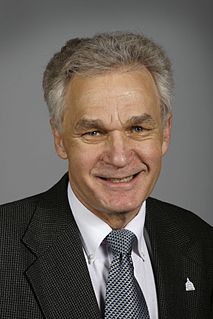
Steven Henning "Steve" Warnstadt was the Iowa State Senator from the 1st District. A Democrat, he has served in the Iowa Senate from 2003 until 2011. He received his BA from Drake University and his MA from Temple University, and is serving as an adjunct instructor with Western Iowa Tech Community College and as an intelligence officer with the Iowa Army National Guard.

Joe M. Seng was the Iowa State Senator from the 45th District. A Democrat, he served in the Iowa Senate from 2003 until 2016. He received a DVM from Iowa State University and worked as a veterinarian in Davenport, running a veterinary clinic for low income families.

Linda L. Upmeyer is the Iowa State Representative from the 54th District. She has served in the Iowa House of Representatives since 2003 and is the current Speaker of the Iowa House of Representatives. She is the first female Speaker in Iowa's history. She received her BSN from the University of Iowa and her MSN from Drake University. On August 19, 2015 was elected by the members of the Iowa House of Representatives Republican majority to serve as the Speaker of the House. Upmeyer's father, Del Stromer served as Speaker from 1981–82.

Patrick Grassley is the Iowa State Representative from the 50th District. He has served in the Iowa House of Representatives since January 2007. He is the grandson of Senator Chuck Grassley.

Todd Taylor is the Iowa State Representative from the 70th District. He has served in the Iowa House of Representatives since 1994. He received his BA from Graceland College and his BS from the University of Northern Iowa.

Jo Oldson is the Iowa State Representative from the 41st District. A Democrat, she has served in the Iowa House of Representatives since 2003. Oldson was born and raised in Eagle Grove, Iowa and resides in Des Moines. She received her BA and JD from Drake University.

Janet Petersen is the Iowa State Senator from the 18th district. She has served in the Iowa Senate since 2013. Previously she served in the Iowa House of Representatives from 2001 to 2013. She received her BA from the University of Northern Iowa and her MA from Drake University.

Rick L. Olson is the Iowa State Representative from the 31st District. A Democrat, he has served in the Iowa House of Representatives since 2005. Olson was born, raised, and resides in Des Moines, Iowa. He attended Grandview College and received his undergraduate degree and his J.D. from Drake University.

Eric J. Palmer is a former Iowa State Representative from the 75th District. A Democrat, he served in the Iowa House of Representatives from 2007 to 2011.

There were two sets of 2006 Iowa House of Representatives elections. The first, the general election, was held on November 7. The second, a special election for District 52, was held on December 12. The representatives-elect from both sets of elections were inaugurated on January 3, 2007. The Iowa House, like the United States House of Representatives, is up for re-election in its entirety every two years. Prior to the elections, the Republicans were in the majority; following inauguration, the Democrats were in the majority – this marked the first time in 42 years that the Democrats had controlled both branches of the Iowa General Assembly and the Governor's Office at the same time.

The 2008 Iowa House of Representatives election were held on November 4, 2008. The Iowa House, like the United States House of Representatives, is up for re-election in its entirety every two years. Prior to the election, the Democrats were in the majority - this marked the first time in 42 years that the Democrats had controlled both branches of the Iowa General Assembly and the Governor's Office. Democrats retained this majority following the 2008 elections.
The following table indicates the party of elected officials in the U.S. state of Iowa:

The 2008 Iowa Senate election were held on November 4, 2008. The Senate seats for the twenty-five even-numbered districts were up for election. Senate terms are staggered such that half the membership is elected every two years, with each Senators serving a four-year term. Prior to the election, the Democrats were in the majority - marking the first time in 42 years that the Democrats had controlled both branches of the Iowa General Assembly and the Governor's Office. They expanded this majority by two seats in the 2008 elections.
Some type of election in Connecticut occurs annually in each of the state’s cities and towns, the exact type of which is dependent on the year. Elections for federal and statewide offices occur in even-numbered years, while municipal elections occur in odd-numbered ones.

The 2014 Iowa Senate election was held on November 4, 2014. The Senate seats for the twenty-five odd-numbered districts were up for election. Senate terms are staggered such that half the membership is elected every two years, with each senator serving a four-year term. Prior to the election, the Democrats were in the majority. They kept this majority after the election.

The 2016 Iowa Senate election was held on November 8, 2016. The Senate seats for the twenty-five even-numbered districts were up for election. Senate terms are staggered such that half the membership is elected every two years, with each Senators serving a four-year term. Prior to the election, the Democrats were in the majority.












